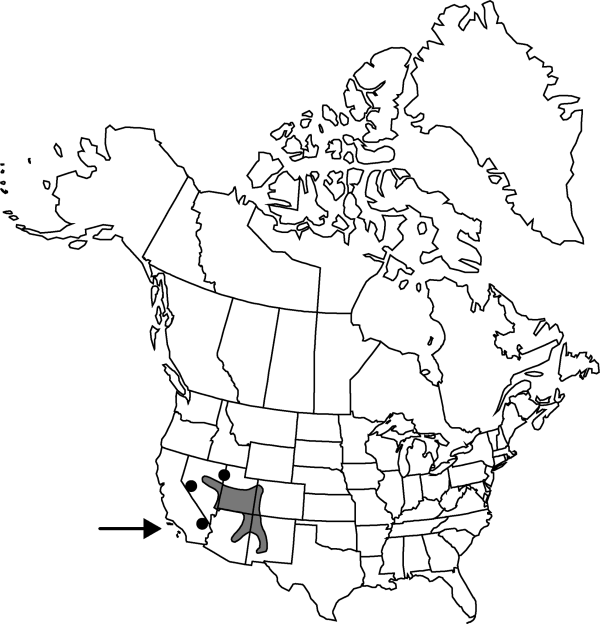Difference between revisions of "Opuntia polyacantha var. hystricina"
Cact. Succ. J. (Los Angeles) 70: 188. 1998.
Common names: Porcupine pricklypear
Basionym: Opuntia hystricina Engelmann & J. M. Bigelow
Synonyms: Opuntia erinacea var. hystricina (Engelmann & J. M. Bigelow) L. D. BensonOpuntia erinacea var. rhodantha (K. Schumann) L. D. Be nsonOpuntia erinacea var. xanthostemma (K. Schumann) L. D. BensonOpuntia rhodantha unknownOpuntia xanthostemma unknown
FNA>Volume Importer |
FNA>Volume Importer |
||
| Line 35: | Line 35: | ||
}}<!-- | }}<!-- | ||
| − | --><span class="statement" id="st- | + | --><span class="statement" id="st-undefined" data-properties=""><b>Stem </b>segments obovate, 8–10 × 5–8 cm; areoles (6–)8–10 per diagonal row across midstem segment, 10–17 mm apart. <b>Spines</b> in most areoles, grading in size and orientation; longer spines (1–)2–6 per areole, slightly descending porrect, ascending near apex, (yellow-gray to) brown to black, (40–)50–80 mm; smaller spines 4–6 per areole, reflexed, gray-white. <b>Fruits</b> stout; areoles 11–21, bearing 4–8 spines, 4–18 mm. <b>2n</b> = 44, 66.</span><!-- |
-->{{Treatment/Body | -->{{Treatment/Body | ||
| + | |phenology=Flowering late spring. | ||
|habitat=Grasslands, pinyon-juniper woodlands, clay or limestone soils | |habitat=Grasslands, pinyon-juniper woodlands, clay or limestone soils | ||
|elevation=1300-1900(-2400) m | |elevation=1300-1900(-2400) m | ||
| Line 56: | Line 57: | ||
|basionyms=Opuntia hystricina | |basionyms=Opuntia hystricina | ||
|family=Cactaceae | |family=Cactaceae | ||
| + | |phenology=Flowering late spring. | ||
|habitat=Grasslands, pinyon-juniper woodlands, clay or limestone soils | |habitat=Grasslands, pinyon-juniper woodlands, clay or limestone soils | ||
|elevation=1300-1900(-2400) m | |elevation=1300-1900(-2400) m | ||
| Line 63: | Line 65: | ||
|publication year=1998 | |publication year=1998 | ||
|special status= | |special status= | ||
| − | |source xml=https://jpend@bitbucket.org/aafc-mbb/fna- | + | |source xml=https://jpend@bitbucket.org/aafc-mbb/fna-data-curation.git/src/9216fc802291cd3df363fd52122300479582ede7/coarse_grained_fna_xml/V4/V4_287.xml |
|subfamily=Cactaceae subfam. Opuntioideae | |subfamily=Cactaceae subfam. Opuntioideae | ||
|genus=Opuntia | |genus=Opuntia | ||
|species=Opuntia polyacantha | |species=Opuntia polyacantha | ||
|variety=Opuntia polyacantha var. hystricina | |variety=Opuntia polyacantha var. hystricina | ||
| − | |||
| − | |||
| − | |||
| − | |||
| − | |||
| − | |||
| − | |||
| − | |||
| − | |||
| − | |||
| − | |||
| − | |||
| − | |||
| − | |||
| − | |||
| − | |||
| − | |||
| − | |||
| − | |||
}}<!-- | }}<!-- | ||
-->[[Category:Treatment]][[Category:Opuntia polyacantha]] | -->[[Category:Treatment]][[Category:Opuntia polyacantha]] | ||
Revision as of 14:03, 27 July 2019
Stem segments obovate, 8–10 × 5–8 cm; areoles (6–)8–10 per diagonal row across midstem segment, 10–17 mm apart. Spines in most areoles, grading in size and orientation; longer spines (1–)2–6 per areole, slightly descending porrect, ascending near apex, (yellow-gray to) brown to black, (40–)50–80 mm; smaller spines 4–6 per areole, reflexed, gray-white. Fruits stout; areoles 11–21, bearing 4–8 spines, 4–18 mm. 2n = 44, 66.
Phenology: Flowering late spring.
Habitat: Grasslands, pinyon-juniper woodlands, clay or limestone soils
Elevation: 1300-1900(-2400) m
Distribution

Ariz., Calif., Colo., Nev., N.Mex., Utah.
Discussion
Selected References
None.
Lower Taxa
None.